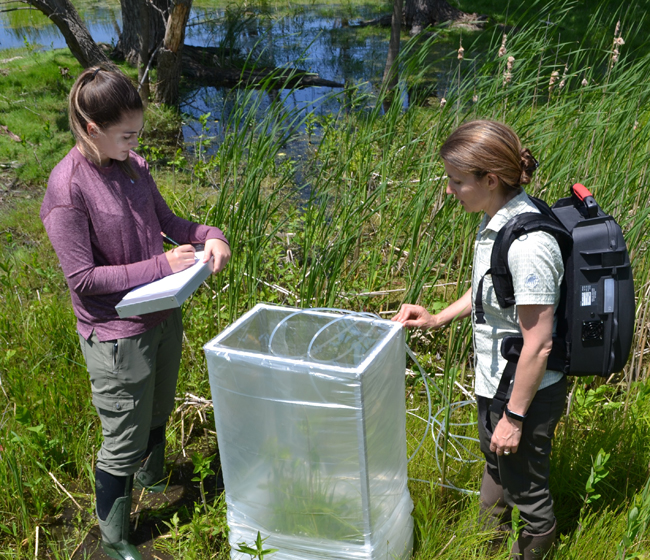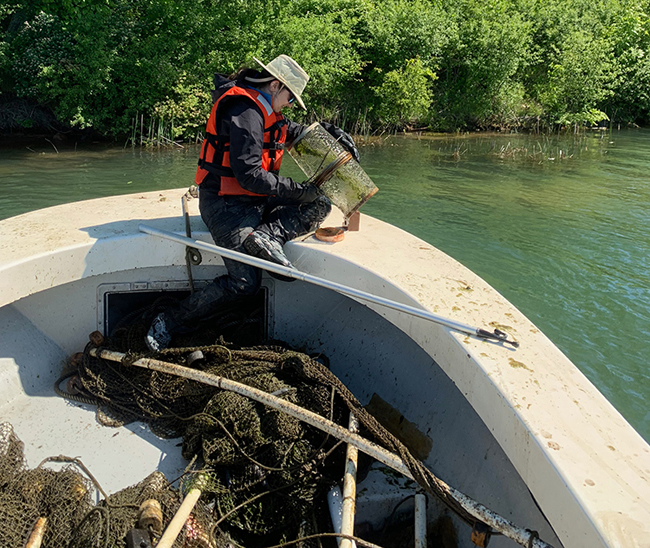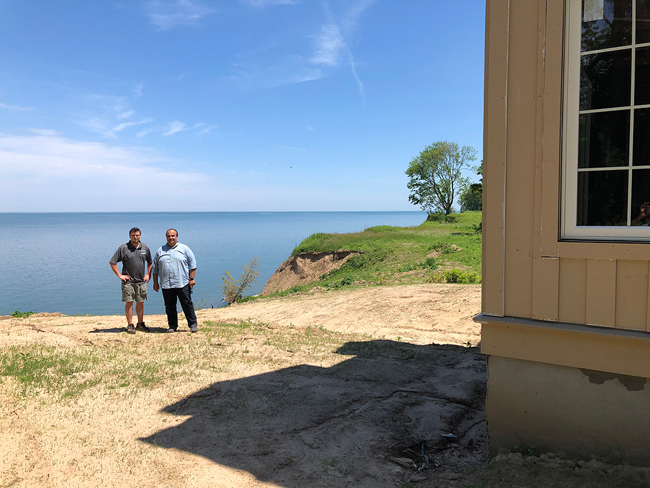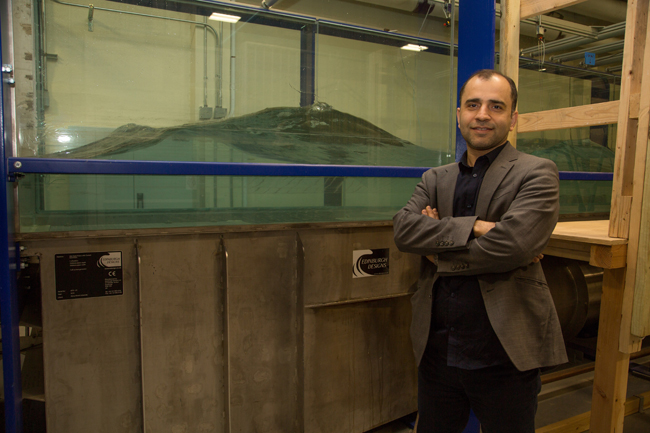Contacts:
Dr. Gregory L. Boyer, Great Lakes Research Consortium Director, SUNY College of Environmental Science and Forestry, P: 315-470-6825
Dave White, Coastal Recreation and Tourism Specialist, New York Sea Grant, E: dgw9@cornell.edu, P: 315-312-3042
Kara Lynn Dunn, Great Lakes Publicist, E: karalynn@gisco.net, P: 315-465-7578
Syracuse, NY, July 18, 2019 - The Great Lakes Research Consortium (GLRC) in partnership with the New York State Department of Environmental Conservation has announced $121,916 in grants for five projects conduced by faculty and students at four State universities: The College at Brockport, the University at Buffalo, Stony Brook University, and the College of Environmental Science and Forestry in Syracuse.
The five projects receiving the GLRC funding will advance the goals of the Great Lakes Action Agenda for New York State for the restoration and protection for freshwater resources locally and, in so doing, establish models for use nationally.
The projects are addressing the application of science to:
. increase shoreline resiliency,
. enhance wastewater treatment to reduce toxic substances,
. assess factors associated with methane gas release from wetlands,
. address the impact of climate change on the processes that influence beach and shoreline erosion, and
. investigate the potential of invasive species to transfer mercury to fish.
Project collaborators include the Town of Amherst; New York Sea Grant Great Lakes; the New York State Office of Parks, Recreation and Historic Preservation; and the Wayne County Soil and Water Conservation District.
Funding for the GLRC grants is provided the New York State Department of Environmental Conservation from the New York State Environmental Protection Fund Ocean and Great Lakes Ecosystem Conservation Act program.
"We are excited about these projects that are exploring innovative approaches for applying science to critical issues facing the Great Lakes and the Great Lakes communities and economies. The results of these projects will not only benefit the Great Lakes region, but have implications for water bodies far beyond," said Great Lakes Research Consortium Director Gregory L. Boyer, Ph.D.
The five grant projects receiving 2019 Great Lakes Research Consortium grants are:

With a grant from the Great Lakes Research Consortium, Rachel Schultz, Ph.D., right, of The College at Brockport, and graduate student Courtney Scoles are assessing the effects of cattail treatment on methane emissions from Lake Ontario coastal wetlands. Credit: Jake Straub.
The College at Brockport, $25,000: Assessing the Effects of Cattail Treatment on Methane Emissions from Lake Ontario Coastal Wetlands. The project is addressing the question of how the eradication of invasive plants, e.g., cattails, influences freshwater wetlands release of methane, a potent greenhouse gas.

SUNY College of Environmental Science and Forestry's graduate student Iman Pakzad is assisting ESF Professor Roxanne Razavi, Ph.D., with the Great Lakes Research Consortium-funded project examining why the tubenose goby, a relative of the established invasive species, round goby, is increasing in abundance in the northeastern Lake Ontario-St. Lawrence River basin. Razavi, assistant professor in the Department of Environmental and Forest Biology, is working in collaboration with John Farrell, Ph.D., professor of aquatic sciences and fisheries science and director of the college's Thousand Islands Biological Station in Clatyon, New York. This investigators will determine the diet and habitat preferences of both species, evaluate the importance of each species to the diets of predators and assess each species for its potential to act as a vector of mercury to higher trophic level fishes. Credit: Jonathan White
SUNY College of Environmental Science and Forestry, Syracuse: $24,966: Food Web Impacts and Contaminant Transfer by the Tubenose Goby in the Lake Ontario-St. Lawrence River Basin. This project is evaluating the habitat and diet preferences of an invasive species that is becoming more abundant in the northeastern Lake Ontario-St. Lawrence River basin and its potential to vector mercury contamination to higher-level fishes.
University at Buffalo, $25,000: Towards Complete Removal of Per- and Polyfluoroalkyl Substances (PFAS) Using a Nanotechnology-Assisted Advanced Water Treatment Process. This project is evaluating the efficacy of an innovative wastewater treatment approach using a nanomaterial-based reactive pretreatment followed by a biological wastewater treatment process to completely degrade per- and polyfluoroalkly compounds. PFAS are organic compounds extensively used in non-sticky consumer products and aqueous fire-fighting foams. The U.S. Environmental Protection Agency has identified PFAS as a priority pollutant for removal from drinking water and food sources.

Sherif L. Abdelaziz, Ph.D., right, a professor in the Department of Civil Engineering at Stony Brook University, Stony Brook, N.Y., and Drew Strakey, a Wayne County Soil and Water Conservation District Technician and Program Specialist, Lyons, NY, are scouting potential locations for research that will test an innovation approach to managing shoreline erosion. With a $25,000 grant award by the Great Lakes Research Consortium (GLRC) in partnership with the New York State Department of Environmental Conservation earlier this year, Abdelaziz will evaluate the use of marine-based, ecosystem-friendly biopolymers as a potential technique for increasing shoreline erosion resistance and protection. The work includes both laboratory experiments and field testing over multiple seasons with a site yet to be named in Wayne County. Credit: Wayne County SWCD.
Stony Brook University, $25,000: Increasing Shoreline Erosion Resiliency Using Marine-Based Biopolymers. This project, with a field demonstration site in Wayne County, is testing the use of ecosystem-friendly and cost-effective marine-based biopolymers as a potential technique for increasing shoreline erosion resistance, restoration and protection at the local and national levels.

Ali Farhadzadeh, Ph.D., leads the Great Lakes Research Consortium-funded project that is developing a basis for computer modeling to address Eastern Lake Erie erosion, sediment transport and depositions under a changing climate. Credit: Stony Brook University.
Stony Brook University, $21,590: Eastern Lake Erie Erosion, Sediment Transport and Depositions Under a Changing Climate. This project is documenting the historical seasonal climate, wave climate, storm surge, beach erosion, and sediment movement along eastern Lake Erie as a basis for computer modeling to identify future impact for Lake Erie shores and beaches.
The Great Lakes Research Consortium, housed at the SUNY College of Environmental Science and Forestry, Syracuse, NY, encompasses 18 colleges and universities in New York and affiliate campuses in Canada. For more information on each project and on GLRC grants for student research, student travel to conferences and workshops, and student internships, visit www.esf.edu/glrc.
More Info: New York Sea Grant
New York Sea Grant (NYSG), a cooperative program of Cornell University
and the State University of New York (SUNY), is one of 33 university-based
programs under the National Oceanic and Atmospheric Administration’s
National Sea Grant College Program.
Since 1971, NYSG has represented a statewide network of integrated
research, education and extension services promoting coastal community
economic vitality, environmental sustainability and citizen awareness
and understanding about the State’s marine and Great Lakes resources.
Through NYSG’s efforts, the combined talents of university scientists
and extension specialists help develop and transfer science-based
information to many coastal user groups—businesses and industries,
federal, state and local government decision-makers and agency managers,
educators, the media and the interested public.
The program maintains Great Lakes offices at Cornell University, SUNY
Buffalo, SUNY Oswego and the Wayne County Cooperative Extension office
in Newark. In the State's marine waters, NYSG has offices at Stony Brook
University in Long Island, Brooklyn College and Cornell Cooperative
Extension in NYC and Kingston in the Hudson Valley.
For updates on Sea Grant activities: www.nyseagrant.org has RSS, Facebook, Twitter, and YouTube links. NYSG offers a free e-list sign up via www.nyseagrant.org/nycoastlines for its flagship publication, NY Coastlines/Currents, which is published quarterly. Our program also produces an occasional e-newsletter,"NOAA Sea Grant's Social Media Review," via its blog, www.nyseagrant.org/blog.